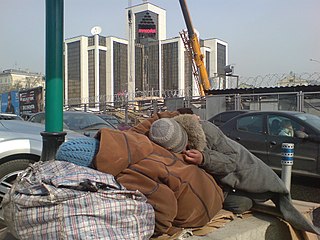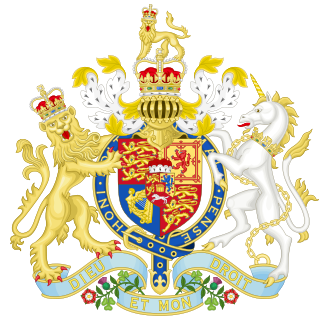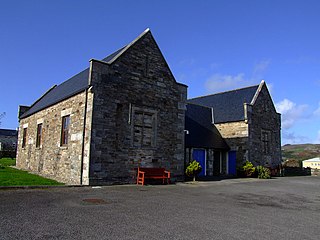
The English Poor Laws were a system of poor relief in England and Wales that developed out of the codification of late-medieval and Tudor-era laws in 1587–1598. The system continued until the modern welfare state emerged after the Second World War.

In Britain, a workhouse was an institution where those unable to support themselves financially were offered accommodation and employment. The earliest known use of the term workhouse is from 1631, in an account by the mayor of Abingdon reporting that "we have erected wthn [sic] our borough a workhouse to set poorer people to work".

Pauperism is poverty or generally the state of being poor, or particularly the condition of being a "pauper", i.e. receiving relief administered under the English Poor Laws. From this, pauperism can also be more generally the state of being supported at public expense, within or outside of almshouses, and still more generally, of dependence for any considerable period on charitable assistance, public or private. In this sense, pauperism is to be distinguished from poverty.

The Poor Law Amendment Act 1834 (PLAA) known widely as the New Poor Law, was an Act of the Parliament of the United Kingdom passed by the Whig government of Earl Grey. It completely replaced earlier legislation based on the Poor Relief Act 1601 and attempted to fundamentally change the poverty relief system in England and Wales. It resulted from the 1832 Royal Commission into the Operation of the Poor Laws, which included Edwin Chadwick, John Bird Sumner and Nassau William Senior. Chadwick was dissatisfied with the law that resulted from his report. The Act was passed two years after the Representation of the People Act 1832 which extended the franchise to middle class men. Some historians have argued that this was a major factor in the PLAA being passed.
A poor law union was a geographical territory, and early local government unit, in the United Kingdom and Ireland.
Outdoor relief, an obsolete term originating with the Elizabethan Poor Law (1601), was a program of social welfare and poor relief. Assistance was given in the form of money, food, clothing or goods to alleviate poverty without the requirement that the recipient enter an institution. In contrast, recipients of indoor relief were required to enter an almshouse, orphanage, workhouse or poorhouse. Outdoor relief consisted of hot meals and provision of blankets and things necessary for homeless persons. Outdoor relief was also a feature of the Scottish and Irish poor Law systems.

The Book of Murder, also known as the Marcus Affair, was a piece of propaganda written in the 1830s in opposition to the English Poor Laws. It was presented as the work of one pseudonymous "Marcus", and was published by Joshua Hobson. It aimed to incite opposition to the Poor Law Amendment Act 1834, which had altered the nature of poor relief in England and Wales. Previously, paupers were eligible for "outdoor relief" ; this shifted to "indoor relief", meaning that workhouses were built, institutions to provide shelter and basic sustenance.

The Poor Relief Act 1601 was an Act of the Parliament of England. The Act for the Relief of the Poor 1601, popularly known as the Elizabethan Poor Law, "43rd Elizabeth" or the Old Poor Law was passed in 1601 and created a poor law system for England and Wales.

The Workhouse Test Act 1723 also known as the General Act or Knatchbull's Act was poor relief legislation passed by the British government by Sir Edward Knatchbull in 1723. The "workhouse test" was that a person who wanted to receive poor relief had to enter a workhouse and undertake a set amount of work. The test was intended to prevent irresponsible claims on a parish's poor rate.

The Relief of the Poor Act 1782, also known as Gilbert's Act, was a British poor relief law proposed by Thomas Gilbert which aimed to organise poor relief on a county basis, counties being organised into parishes which could set up poorhouses or workhouses between them. However, these workhouses were intended to help only the elderly, sick and orphaned, not the able-bodied poor. The sick, elderly and infirm were cared for in poorhouses whereas the able-bodied poor were provided with poor relief in their own homes. Gilbert's Act aimed to be more humane than the previous modification to the Poor Law, the Workhouse Test Act. During the 1780s, there was an increase in unemployment and underemployment due to high food prices, low wages and the effects of enclosing land. This caused poor rates to increase rapidly, which wealthy landowners found unacceptable.

In English and British history, poor relief refers to government and ecclesiastical action to relieve poverty. Over the centuries, various authorities have needed to decide whose poverty deserves relief and also who should bear the cost of helping the poor. Alongside ever-changing attitudes towards poverty, many methods have been attempted to answer these questions. Since the early 16th century legislation on poverty enacted by the English Parliament, poor relief has developed from being little more than a systematic means of punishment into a complex system of government-funded support and protection, especially following the creation in the 1940s of the welfare state.
From the reign of Elizabeth I until the passage of the Poor Law Amendment Act in 1834 relief of the poor in England was administered on the basis of a Poor Law enacted in 1601. From the start of the nineteenth century the basic concept of providing poor relief was criticised as misguided by leading political economists and in southern agricultural counties the burden of poor-rates was felt to be excessive (especially where poor-rates were used to supplement low wages. Opposition to the Elizabethan Poor Law led to a Royal Commission on poor relief, which recommended that poor relief could not in the short term be abolished; however it should be curtailed, and administered on such terms that none but the desperate would claim it. Relief should only be administered in workhouses, whose inhabitants were to be confined, 'classified' and segregated. The Poor Law Amendment Act allowed these changes to be implemented by a Poor Law Commission largely unaccountable to Parliament. The Act was passed by large majorities in Parliament, but the regime it was intended to bring about was denounced by its critics as un-Christian, un-English, unconstitutional, and impracticable for the great manufacturing districts of Northern England. The Act itself did not introduce the regime, but introduced a framework by which it might easily be brought in.

The 1832 Royal Commission into the Operation of the Poor Laws was a group set up to decide how to change the Poor Law systems in England and Wales. The group included Nassau Senior, a professor from Oxford University who was against the allowance system, and Edwin Chadwick, who was a Benthamite. The recommendations of the Royal Commission's report were implemented in the Poor Law Amendment Act 1834.

The Irish Poor Laws were a series of Acts of Parliament intended to address social instability due to widespread and persistent poverty in Ireland. While some legislation had been introduced by the pre-Union Parliament of Ireland prior to the Act of Union, the most radical and comprehensive attempt was the Irish act of 1838, closely modelled on the English Poor Law of 1834. In England, this replaced Elizabethan era legislation which had no equivalent in Ireland.
The Scottish Poor Laws were the statutes concerning poor relief passed in Scotland between 1579 and 1929. Scotland had a different Poor Law system to England and the workings of the Scottish laws differed greatly to the Poor Law Amendment Act which applied in England and Wales.
Poor Law policy after the New Poor Law concerns the time period c. 1847–1900 after the implementation of the Poor Law Amendment Act until the beginnings of the decline of the Poor Law system at the start of the 20th century.
The following article presents a Timeline of the Poor Law system from its origins in the Tudor and Elizabethan era to its abolition in 1948.

The Poor Relief (Ireland) Act 1838 is an Act of the Parliament of the United Kingdom that created the system of poor relief in Ireland. The legislation was largely influenced by the English Poor Law Act of 1834.
In the United Kingdom, a pauper's funeral was a funeral for a pauper paid for under the Poor Law. This policy addressed the condition of the poor people of Britain, such as those living in the workhouses, where a growing population of the British ended their days from the 1850s to the 1860s. This period saw between 32 and 48 percent increase in the proportion of the elderly and the sick paupers in these institutions. An account described how poor people could not avail themselves of the funeral relief until they entered the workhouse.
In 2002, nursing homes in the United Kingdom were officially designated as care homes with nursing, and residential homes became known as care homes.











